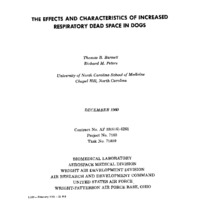-
Title
-
The Effects And Characteristics Of Increased Respiratory Dead Space In Dogs
-
Date
-
1960
-
Index Abstract
-
Contrails and DTIC
-
Photo Quality
-
Incomplete
-
Report Number
-
WADD TR 60-660
-
Creator
-
Barnett, Thomas B.
-
Peters, Richard M.
-
Corporate Author
-
University Of North Carolina School Of Medicine
-
Laboratory
-
Biomedical Laboratory
-
Extent
-
14
-
PB Number
-
PB154168
-
Identifier
-
AD0258788
-
Access Rights
-
OTS
-
Distribution Classification
-
1
-
Contract
-
AF 33(616)-6261
-
DoD Project
-
7163
-
DoD Task
-
71819
-
DTIC Record Exists
-
No
-
Distribution Change Authority Correspondence
-
None
-
Report Availability
-
Full text available
-
Full text available
-
Date Issued
-
1960-12
-
Abstract
-
Artificial breathing apparatus such as oxygen masks involves added external respiratory dead space. In dogs with permanent tracheostomies, chronic increase in dead space has been maintained with lengths of 0.75-inch interior diameter vinyl plastic tubing. A dead space of 2030 cc./kg. is not tolerated for more than 24 hours. The amount of mixing and air streaming within this tubing and in tubing of 0.5-inch interior diameter and 1.5-inch interior diameter was determined. There was very little mixing in the two smaller tubes but, in the large one, the amount of mixing was significant.
-
Provenance
-
IIT
-
Type
-
report
-
Publisher
-
Wright-Patterson Air Force Base, OH : Biomedical Laboratory, Aerospace Medical Division, Wright Air Development Division, Air Research and Development Command, United States Air Force
-
Distribution Conflict
-
No
-
Format
-
1 online resource
 WADDTR60-660.pdf
WADDTR60-660.pdf